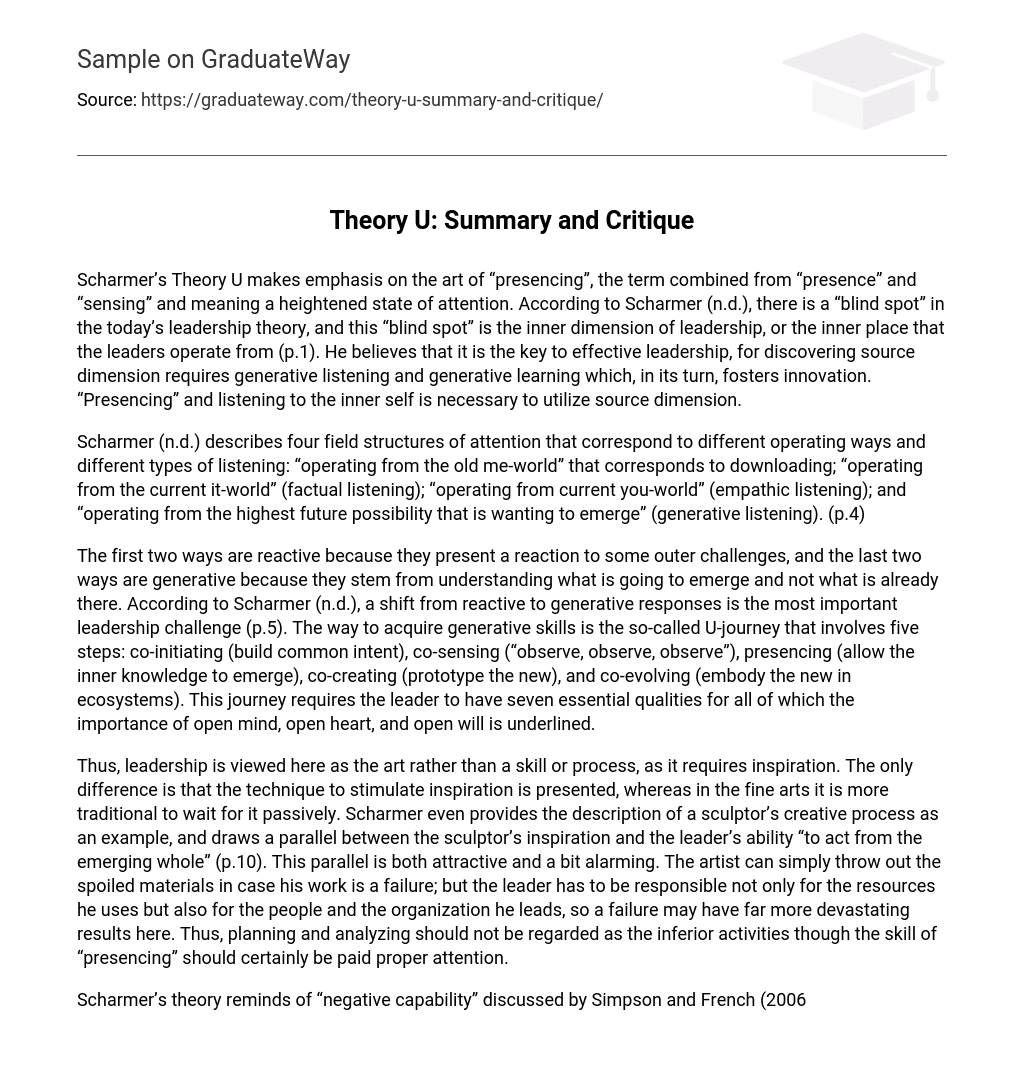Scharmer’s Theory U makes emphasis on the art of “presencing”, the term combined from “presence” and “sensing” and meaning a heightened state of attention. According to Scharmer (n.d.), there is a “blind spot” in the today’s leadership theory, and this “blind spot” is the inner dimension of leadership, or the inner place that the leaders operate from (p.1). He believes that it is the key to effective leadership, for discovering source dimension requires generative listening and generative learning which, in its turn, fosters innovation. “Presencing” and listening to the inner self is necessary to utilize source dimension.
Scharmer (n.d.) describes four field structures of attention that correspond to different operating ways and different types of listening: “operating from the old me-world” that corresponds to downloading; “operating from the current it-world” (factual listening); “operating from current you-world” (empathic listening); and “operating from the highest future possibility that is wanting to emerge” (generative listening). (p.4)
The first two ways are reactive because they present a reaction to some outer challenges, and the last two ways are generative because they stem from understanding what is going to emerge and not what is already there. According to Scharmer (n.d.), a shift from reactive to generative responses is the most important leadership challenge (p.5). The way to acquire generative skills is the so-called U-journey that involves five steps: co-initiating (build common intent), co-sensing (“observe, observe, observe”), presencing (allow the inner knowledge to emerge), co-creating (prototype the new), and co-evolving (embody the new in ecosystems). This journey requires the leader to have seven essential qualities for all of which the importance of open mind, open heart, and open will is underlined.
Thus, leadership is viewed here as the art rather than a skill or process, as it requires inspiration. The only difference is that the technique to stimulate inspiration is presented, whereas in the fine arts it is more traditional to wait for it passively. Scharmer even provides the description of a sculptor’s creative process as an example, and draws a parallel between the sculptor’s inspiration and the leader’s ability “to act from the emerging whole” (p.10). This parallel is both attractive and a bit alarming. The artist can simply throw out the spoiled materials in case his work is a failure; but the leader has to be responsible not only for the resources he uses but also for the people and the organization he leads, so a failure may have far more devastating results here. Thus, planning and analyzing should not be regarded as the inferior activities though the skill of “presencing” should certainly be paid proper attention.
Scharmer’s theory reminds of “negative capability” discussed by Simpson and French (2006). In both cases, the importance of passive listening is underlined. “Thoughts in search of a thinker” (Simpson & French, 2006, p.250) are, in essence, what Scharmer (n.d.) calls “the emerging whole” (p.10); both notions relate to the ideas or states that have not emerged yet but can already be sensed in the air. Allowing “time out” proposed by Simpson and French (2006, p.253) is similar to the requirement to “retreat and observe” put forth by Scharmer (n.d., p.5). Both theories focus on the skill of retreating from activity for the sake of activity and allowing new thoughts to emerge.
In this respect, the theories also remind of two more concepts learnt earlier: mental models and balcony perspective. For the observation to be effective, Scharmer advises to have the mind and heart wide open, and this means not subjected to the impact of stereotypes and mental models (Senge, 1990) that can seriously distort our perception. Scharmer calls this phenomenon “voice of judgment” and illustrates its influence describing Ford case (p.9). To understand what is really going on, Heifetz offers to take a balcony perspective, or to distance oneself from the separate facts and view the situation as a whole (as cited in Gallos, 2008, p. 449). Similarly, Scharmer (n.d.) underlines the need “to act and operate from the larger whole” and “play the macro violin” (p.12).
Therefore, different researchers give different names to the phenomena described above, but the essence is the same: they all underline the importance of open mind and attract attention to the inner space of leadership. I think, everybody can remind at least one case when “retreat and reflect” tactics worked: quite often, a solution to a complex problem comes to mind not upon a restless thinking process but upon a break.
References
Gallos, J.V. (2008). Business leadership: A Jossey-Bass reader. (2nd ed.). San-Francisco, CA: John Wiley and Sons.
Scharmer, C.O. (n.d.). “Addressing the blind spot of our time.” An executive summary of the new book by Otto Scharmer Theory U: Leading from future as it emerges. http://www.theoryU.com
Senge, P.M. (1990). Mental models. In The fifth discipline: The art and practice of the learning organization (pp.175-204). New York, NY: Doubleday/Currency.
Simpson, P., & French, R. (2006). Negative capability and the capacity to think in the present moment: Some implications for leadership practice. Leadership, 2(2), 245-255.





